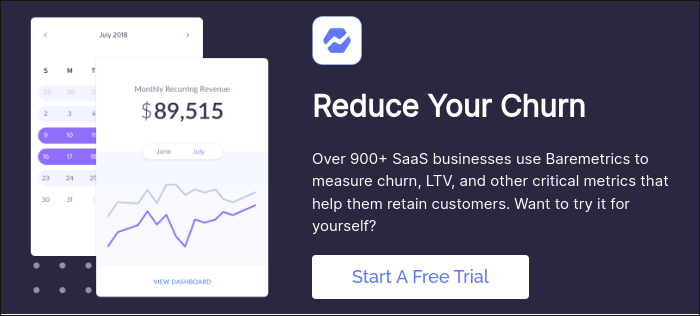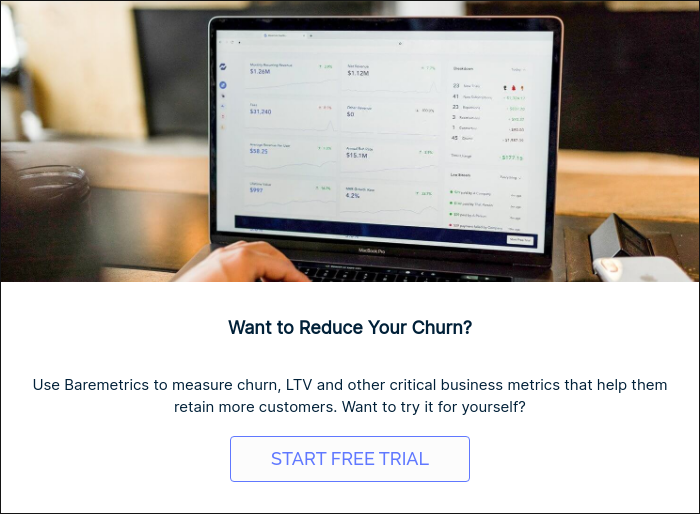Table of Contents
Recurring revenue is the backbone of SaaS and subscription-based companies. At these companies, customers purchase a service on a consistent basis, giving the company the ability to project future revenue more accurately. Recurring revenue can be calculated with metrics like churn rate and user growth rate for a realistic view of the company’s future income. This type of predictability is very valuable in business.
Non-recurring revenue is made up of one-off payments that may or may not happen again. For instance, assume a SaaS company launches an event and gets 50 people to buy tickets. The revenue from this event is non recurring because it’s hard to assume that attendees will return next year (if there is a next year). It’s much more likely they’ll continue paying for SaaS that’s integrated into their business.
Examples of each revenue type
Recurring Revenue* Software-as-a-Service (Adobe)* Streaming Service (Netflix)* Hosting Service (Digital Ocean)Non Recurring Revenue* Short-Term Housing Provider (AirBNB)* Ticket Seller (Ticketmaster)* Grocery Store (Whole Foods)
It’s important to note that these are the primary revenue models and not the only revenue models for each company. For instance, Amazon now lets shoppers subscribe to receive products periodically. In return, shoppers are given a discount for their loyalty, representing the value a recurring revenue model has for Amazon.
Adobe’s move to recurring revenue
On April 23, 2012, Adobe moved from a non recurring revenue-based product model to a recurring revenue-based subscription model when it announced Adobe Creative Cloud. This change resulted in a 35% decrease in revenue the following year. However, according to Harvard Business Review, “in April 2016 Adobe’s stock price had nearly tripled from its value four years earlier.”
Even though Adobe experienced short-term losses, the company understood the long-term value of shifting to a model that offers more predictability. Before the Creative Cloud offering, Adobe had limited insight into future income. They could only assume customers with earlier versions of the software would buy newer versions. Nothing was pressing them to pay Adobe more money. Now, in return for customers paying on a monthly basis, Adobe gives them newer versions of software at no additional cost.
Non-recurring doesn’t mean zero predictability
You can always predict future revenue by reviewing past metrics. There are many factors that will affect the accuracy of your predictions, but one of the strongest factors is originality. The more original your product is, the more likely previous customers will continue buying from you and new customers will show up.
Take Airbnb for instance. It created a strong community and platform that can’t be found anywhere else online. Because of this, Airbnb can make assumptions more confidently than, say, a ticket provider that competes with other ticket providers on price and availability. In the end, a ticket is just a ticket. An Airbnb is not just a hotel.
The benefits of each revenue type
Rob Go, the cofounder of Nextview Ventures, argues a case for non recurring revenue businesses that have large but infrequent transactions. He also mentions the benefits of each revenue type, some of which are mentioned below.
Recurring revenue
- Predictability. People paying you now are likely to keep paying you in the future.
- More multiples. There are more stable metrics which makes it easier to calculate the value of the business in multiple ways.
- Higher lifetime value. Because you’re providing value over time, the customer will do the same for you.
Non recurring revenue
- Faster growth. Since you’re charging a one time fee, you can charge more, which gives you more immediate money to invest in growth.
- Big margins. “Some companies might kill to half the dollars of contribution margin over 12 months that a non recurring business gets on its first transaction,” says Go.
- Other offerings. Being a non recurring business doesn’t limit you to one offering; you can also create related offerings.
Which revenue type to choose
While producers of popular software have shifted to SaaS built on recurring revenue (Adobe, Microsoft, etc), this doesn’t mean recurring revenue is the way. Each piece of software is unique and each creator has different goals. Think about your goals and base your revenue model on them.
Are you producing software that you don’t anticipate updating in the near future and want to use for passive income? Non recurring is probably the best way to go. Or are you producing software that you want to iterate on and use as the foundation for a thriving business? Recurring might be better.



